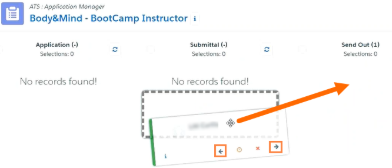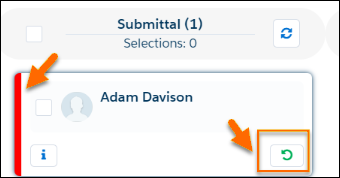Job : Kanban Board
This article applies to s using the data model only.
Overview
Kanban shows you all the candidates![]() A person looking for a job. A candidate can also be referred to as a Job Seeker, Applicant, or Provider. applied to a Job in the form of cards that display customizable Candidate
A person looking for a job. A candidate can also be referred to as a Job Seeker, Applicant, or Provider. applied to a Job in the form of cards that display customizable Candidate![]() A person looking for a job. A candidate can also be referred to as a Job Seeker, Applicant, or Provider. information. The cards are ordered in columns (sometimes referred to as swimlanes) that represent the job application stages: Longlist (optional), Application
A person looking for a job. A candidate can also be referred to as a Job Seeker, Applicant, or Provider. information. The cards are ordered in columns (sometimes referred to as swimlanes) that represent the job application stages: Longlist (optional), Application![]() First stage of Job placement flow (Application> Submittal>Interview>Offer> Placement), Submittal
First stage of Job placement flow (Application> Submittal>Interview>Offer> Placement), Submittal![]() The Second Stage of Job application flow. This is when the recruiter sends the Candidate CV to the client, a sort of first introduction., Send Out
The Second Stage of Job application flow. This is when the recruiter sends the Candidate CV to the client, a sort of first introduction., Send Out![]() The third Stage of Job application flow. This is when the recruiter sets up a job interview between Candidate and Client., Offer
The third Stage of Job application flow. This is when the recruiter sets up a job interview between Candidate and Client., Offer![]() The fourth Stage of Job application flow. This is when the candidate is offered the position (details about salary, locations etc are shared and candidate decides if he wants to take the job), and Closing Report
The fourth Stage of Job application flow. This is when the candidate is offered the position (details about salary, locations etc are shared and candidate decides if he wants to take the job), and Closing Report![]() Fifth Stage of Job placement flow, a Candidate that reaches the Closing Report Placement stage has been assigned to a job. In Bullhorn Recruitment Cloud, a 'Closing Report' is a record that captures all the information related to the newly filled position (name of Candidate, position, salary, start date, which recruiter gets credit for the hire etc.). Candidate cards can be moved to different columns to reflect the Job Stage they are at.
Fifth Stage of Job placement flow, a Candidate that reaches the Closing Report Placement stage has been assigned to a job. In Bullhorn Recruitment Cloud, a 'Closing Report' is a record that captures all the information related to the newly filled position (name of Candidate, position, salary, start date, which recruiter gets credit for the hire etc.). Candidate cards can be moved to different columns to reflect the Job Stage they are at.
This article reviews the features of the Kanban Board.
Kanban Layout
- Job Title: You can click to change selection (the Select a Job pop up appears). A pop up of the Job record displays when you hover over the
 information icon; if you click it, you navigate to the actual Job record.
information icon; if you click it, you navigate to the actual Job record. - Job Application Stage: The column header shows the Stage name, and in brackets, the number of candidates in that Stage. If there are candidates in the column that have been selected (to be moved, rejected etc.), that information is also displayed in the column header. A refresh button is available.
- Candidate Cards: Each Candidate that has been applied to the job is represented by a card that displays basic Candidate information. The cards also include action buttons so the Candidate can be moved through the application process to different stages.

Admin Note:
There are customization options for the way data is displayed on cards and columns on the Kanban Board. See ATS v1: Customize the Kanban Board for more information.
Moving Candidates
If you are focusing on one candidate at a time, you can drag-and-drop the card that represents them to a swimlane![]() Clusters, or Swimlanes, are servers that hold our customer's databases, each cluster is like an apartment building and each customer's database is like an individual apartment. (column) to place them in a different stage. Dragging and dropping is only allowed for moving a candidate forward. To move back, use the action button.
Clusters, or Swimlanes, are servers that hold our customer's databases, each cluster is like an apartment building and each customer's database is like an individual apartment. (column) to place them in a different stage. Dragging and dropping is only allowed for moving a candidate forward. To move back, use the action button.
When the candidate card is moved successfully, you will receive a message, "The Card![]() If in the context of ATS, a 'card' or 'tile' is the visual representation on the ATS board of a Candidate at various stages of the application process Ordering has been updated successfully." If a card move is not permitted, you will receive an error message.
If in the context of ATS, a 'card' or 'tile' is the visual representation on the ATS board of a Candidate at various stages of the application process Ordering has been updated successfully." If a card move is not permitted, you will receive an error message.
If you want to select more than one candidate at a time or perform any mass action, use the Action![]() When used in ATS or Search and Match UI, one of multiple actions available after user has selected a sub-set of Candidates Toolbar. See Job ATS v1: Actions Toolbar for more details.
When used in ATS or Search and Match UI, one of multiple actions available after user has selected a sub-set of Candidates Toolbar. See Job ATS v1: Actions Toolbar for more details.
Action Buttons
Use theMove Back icon  to move your candidate back. Candidates can only be moved back to the previous stage and Move Back is not allowed from Closing Report or Application.
to move your candidate back. Candidates can only be moved back to the previous stage and Move Back is not allowed from Closing Report or Application.
Use the Move Forwardicon  to move your candidate forward to any stage past their current stage.
to move your candidate forward to any stage past their current stage.
You can Reject a candidate by clicking the red "x" icon  . This results in the Candidate remaining in the same Stage, but with Status of Rejected. No further action is possible for that candidate on the job unless the option to Undo Reject is chosen. When a candidate is Rejected, their card appears with a red sidebar.
. This results in the Candidate remaining in the same Stage, but with Status of Rejected. No further action is possible for that candidate on the job unless the option to Undo Reject is chosen. When a candidate is Rejected, their card appears with a red sidebar.
NOTE: Reject is not available for Candidates in the Longlist or Closing Report stage.
If you want to Undo Reject for any of the rejected candidates, click the Undo Reject icon  . This button is only visible on Rejected Candidates cards.
. This button is only visible on Rejected Candidates cards.
The Delete  icon is only enabled for Candidate Cards in Longlist.
icon is only enabled for Candidate Cards in Longlist.
The information icon  on the card allows you to view the Stage record for the candidate. For example, if you click the icon of a card in Submittal, the popup will show you the Submittal record that was created in the background when the candidate was moved.
on the card allows you to view the Stage record for the candidate. For example, if you click the icon of a card in Submittal, the popup will show you the Submittal record that was created in the background when the candidate was moved.
In-line editing is possible in the popup, so you can update the record without leaving the .
Admin Note:
If you do not want to have the Information icon on the card, it can be removed. Follow the steps in ATS v1: Customize the Kanban Board to access the Custom Metadata Type Swimlane Config and deselect the Show Info Button checkbox for all the relevant stages.


